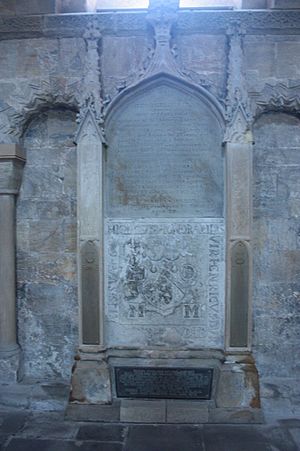George Durie facts for kids
Quick facts for kids
George Durie
|
|
|---|---|
| Born | c. 1496 |
| Died | 1577 Dunfermline (?)
|
| Education | University of St Andrews, MA (1531) |
| Occupation | Abbot of Dunfermline |
| Spouse(s) | Katherine Sibbald (mistress) |
| Children | Peter, Henry, George, John, not to be confused with his cousin John, Protestant Minister, or that John's grandson John, protestant divine and Ireneist |
| Parent(s) | John Durie & Janet née Beaton |
George Durie (died 1577) was an important religious leader in Scotland during a time of big changes. He was the abbot of Dunfermline Abbey and an archdeacon of St Andrews. He was born around 1496 in Fife.
George Durie's father was John Durie. His brother, Andrew Durie, became a bishop. From 1527 to 1530, George helped manage the monastery of Arbroath. He also started taking on duties as abbot of Dunfermline. He did this under the guidance of his uncle, Archbishop James Beaton. When his uncle died in 1539, King James V made George the full abbot.
Contents
Fighting New Religious Ideas
George Durie was a strong supporter of the traditional Catholic faith. He worked hard to stop new religious ideas, known as Protestantism, from spreading in Scotland.
In 1527, he was part of a court that judged Patrick Hamilton. Hamilton was one of the first people in Scotland to be punished for his Protestant beliefs. George Durie was very active in trying to stop these new teachings. He even brought his own cousin, John Durie, to trial for his beliefs. However, his cousin was later freed.
George Durie worked closely with the archbishops of St Andrews. Together, they led many efforts to stop the spread of Protestantism. When Cardinal Beaton was killed in 1546, George Durie tried to get revenge. He suggested a plan to trick the attackers into surrendering.
Working with the Government
George Durie was also involved in Scottish politics. He attended several parliament meetings in the 1540s and 1550s. In 1554, when Mary of Guise became the queen-regent (the person ruling for the young queen), he was the keeper of the privy seal. This was an important job, like being a top government official.
He also served as an extraordinary lord in 1541. He was often chosen as one of the "lords of the articles." These were people who helped decide which laws parliament would discuss. In 1545, he was part of a special meeting in Stirling. This meeting helped different groups in the government agree on how to work together. George Durie was appointed to the queen-regent's privy council. He continued to serve on this council in 1547. This was just before the battle of Pinkie, a major battle with England.
Loyalty to the Queen
George Durie remained loyal to the queen-regent, Mary of Guise. Even when many others left her side, he stayed with her. He went with her to Leith when she had to retreat there. The Catholic leaders relied on French soldiers for help. The Scottish Protestants, however, asked England for help.
The Catholics then sent George Durie to France. His job was to tell King Francis and Queen Mary about the situation in Scotland. Even though he was 67 years old, he was still very determined. He left for France in January 1560.
Later that year, the Scottish parliament voted to get rid of the Catholic Church in Scotland. They sent someone to France to get Queen Mary's approval. Many in Scotland believed that George Durie, who was at the French court, influenced the queen to reject this request.
Advising Queen Mary
In December, King Francis II died. Both Protestants and Catholics sent groups to France to ask Queen Mary to return to Scotland. George Durie had been with the queen before her mother and husband died. He was also with her when she visited her relatives in Rheims and Joinville.
When Queen Mary was preparing to return to Scotland, she wanted a peaceful arrival. She decided not to deal with religious issues right away. However, George Durie and another bishop strongly advised her to do the opposite.
Later Life and Death
George Durie left France in January 1561. He was later removed from his church positions because he stayed loyal to the Catholic faith.
He died in October 1577. By this time, he was suffering from old age. He was honored by the Catholic Church after his death. Some writers of that time called him a saint.
George Durie had several children. His two oldest sons, Peter and Henry, were officially recognized by law in 1543. His younger sons, George and John, were sent to study in Paris and then at the Catholic University of Leuven. One of his sons, John Durie, became a Jesuit priest.
George Durie is buried in the north aisle of Dunfermline Abbey.


